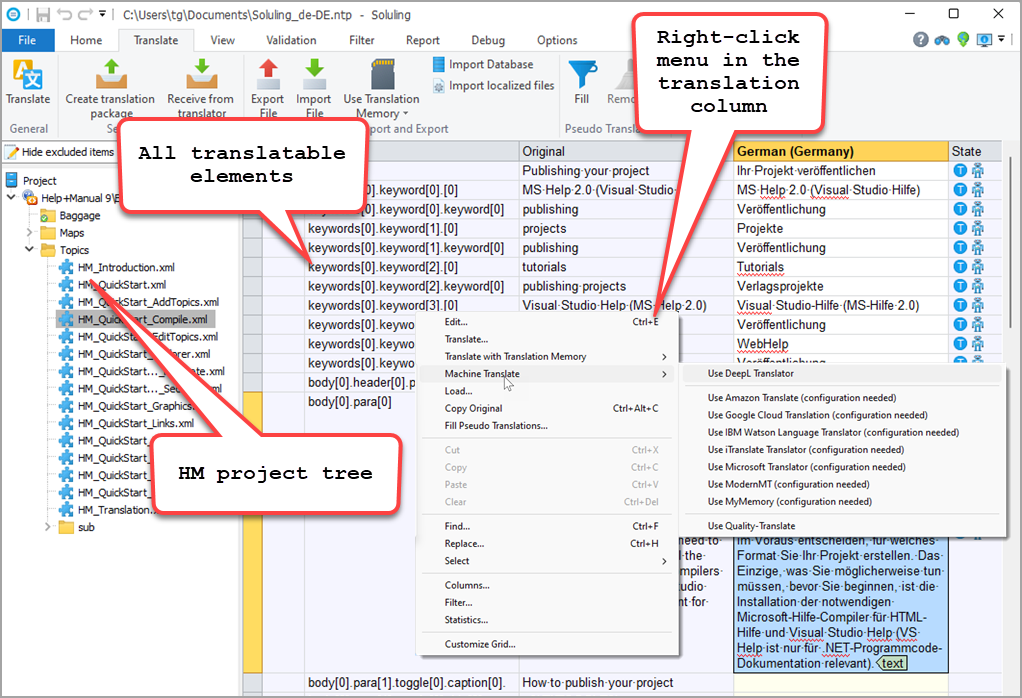Translate Help+Manual projects and localize your software
Soluling is a powerful new translation tool for Help+Manual projects, software user interfaces, web content and much more. It offers a unique combination of support for multiple machine translation services with human translators, along with translation and terminology memory. The most important points for Help+Manual users are:
- Supports Help+Manual projects (HMXP) directly
- Also supports translation of software user interfaces, including most current IDEs
- Help+Manual is just one of the many formats supported — over 100 in total
- Supports machine translation with DeepL and many other services (Amazon, Google, IBM etc.)
- Machine translation is very flexible, allowing combination of multiple services and human translators
- Also supports translation by human services, crowd sourcing, direct manual translation and more
- Translate by paragraph, multiple paragraphs or in bulk for entire topics and projects
- Directly generates translated versions of the originals — no conversion necessary
- Includes translation memory so that unchanged texts and phrases in your projects get translated automatically
- Includes terminology memory to build consistency for your terminology translations
- Both translation and terminology memory have cloud versions for simultaneous access by teams
- All services and translation options are highly configurable, allowing fine-tuning of performance and results
For more information and downloads visit the Soluling website at https://www.soluling.com/.
Translating Help+Manual projects
Translating Help+Manual projects in Soluling is a simple process. Basically, you point the program at a HMXP project and it loads the project tree and its content in a spreadsheet-like interface. You can translate manually directly in the right column. Or if you are using machine translation you right-click in the empty target language column and choose your configured translation service. Similarly, you can also use your translation memory there once it has been set up. Any XML tags within the paragraphs are shown, but this doesn’t trip the system up. Sentences are always handled as entire units, no matter how many sub-tags they contain. This is a pleasant contrast to some other XML-based translation tools.

Translating a HM project in Soluling
Bulk machine and memory translation
The spreadsheet paradigm makes bulk translation very simple. For a topic you select the topic file, press CTRL+A in the target column to select everything, then right-click and select your translation service or your translation memory. Translating the entire project with a single click works in the same way: Selecting the project name at the top of the tree on the left displays all the translatable elements in the entire project on the right. Then you just select them all and choose your translation service or your translation memory.
Translation memory and terminology features
The integration of translation and terminology memory is another major feature of Soluling. Once you are satisfied with your translation you can save it to the integrated translation memory database for your project. When the Help+Manual project is updated you just need to apply the translation memory to get perfect translations for all the text that hasn’t changed. Then you only need to work on what is new and changed.
By default, translation memory works with sentences as the basic unit, but you can also configure Soluling to handle phrases and other meaningful language units in the translation memory. It is extensively and minutely configurable, like everything else in this impressive tool. And in addition to your own translation memory database, Soluling can also integrate the Microsoft Terminology Service and the MyMemory translation memory service.
Similarly, you can also configure a terminology database that will automatically translate any defined terms in the predefined way for maximum consistency. And here too, you can combine your own database with the Microsoft Terminology Service.
Teamwork and cloud features
Soluling supports working on your translation projects in teams. You can generate Soluling packages to send to multiple translators and then integrate their results into your main project. And the translation memory and terminology databases can be maintained as cloud-based versions so that all translators can access them directly.
Software user interface translation
This goes beyond the scope of this review, but as already mentioned, Soluling isn’t only for translating Help+Manual projects, web content and a total of over 100 other different input formats. It is also a full software localization tool, with a complete set of powerful and configurable features for translating and localizing the entire user interface of your application. Visit the Soluling website for more information on this.